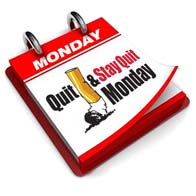We all make New Year’s resolutions. We even intend to keep them. Sometimes, despite our best intentions, we slip up, we get off track, and we swear to try again next year. Quitting smoking is one of the most common New Year’s resolutions and also one of the most difficult to keep. In fact, for many first time quitters, it takes of 8-11 times before they successfully stay quit.
Quitting smoking is one of the most common New Year’s resolutions and also one of the most difficult to keep. In fact, for many first time quitters, it takes of 8-11 times before they successfully stay quit.
Smoking is more harmful than you think
Public health practitioners recognize quitting can be extremely challenging for smokers, but emphasize just how important it is to reduce the serious health risks associated with tobacco use. Tobacco is still the leading preventable cause of death in the United States, and smoking cigarettes is responsible for 1 in every 5 of those deaths. While smoking affects everyone, men have a special stake in the issue because they tend to smoke more than women. Most men know that smoking can lead to health problems such as emphysema, many types of cancer, coronary heart disease, and stroke, but what they less often know is that it may also decrease fertility, increase risk of erectile dysfunction, and cause premature aging. Quitting can help reverse some of the damage smoking inflicts on your body, so it’s important to quit as soon as possible and let your body start the healing process.
A fresh approach to quitting
Many public health agencies attempt to address tobacco use with hard-hitting social marketing campaigns that shock audiences with images of diseased lungs, amputated fingers, men with holes in their throats, or suffering cancer patients. Sensationalized anti-smoking ads are controversial because without providing a distinct strategy for quitting, smokers may just ignore them.
The Monday Campaigns, a non-profit public health initiative in New York City, launched “Quit & Stay Quit Monday,” a campaign that takes a different approach, giving current smokers a realistic strategy to quit – use Monday. Knowing that first time quitters will inevitably slip up, Quit & Stay Quit Monday encourages them to use Monday as a day to recover from the occasional slip. In other words, instead of calling it a failure and waiting for the next New Year’s Day to quit again, the campaign encourages quitters to quit again on Monday, the “January of the week.”
What makes Monday fresh?
Monday marks a natural beginning of our week and an opportunity to get off to a healthy start. A survey of conducted by the National Cancer Institute on their smokefree.gov website found that 53% of people picked Monday as their preferred day of the week to quit smoking. This result is consistent with Google searches for smoking cessation terms (i.e. “quit smoking”): Searches were higher on Monday than any other days of the week, demonstrating that people are actively thinking about quitting on Monday.
How you can Quit and Stay Quit
Make Monday the day you reflect on your quit. If you’re struggling and need additional help, join a tobacco cessation group or call a quit counselor. You can also connect to the online community of quitters on Facebook, Twitter , and Pinterest to get tips each Monday on how to stay on track with your quit.
You may have slipped up and smoked over the weekend, but don’t let a minor slip turn into a full-blown relapse. Instead, think about what caused you to slip, and give yourself a fresh start on Monday.
To learn more about Quit & Stay Quit Monday, start your own campaign, and get free creative materials, visit the campaign website.



